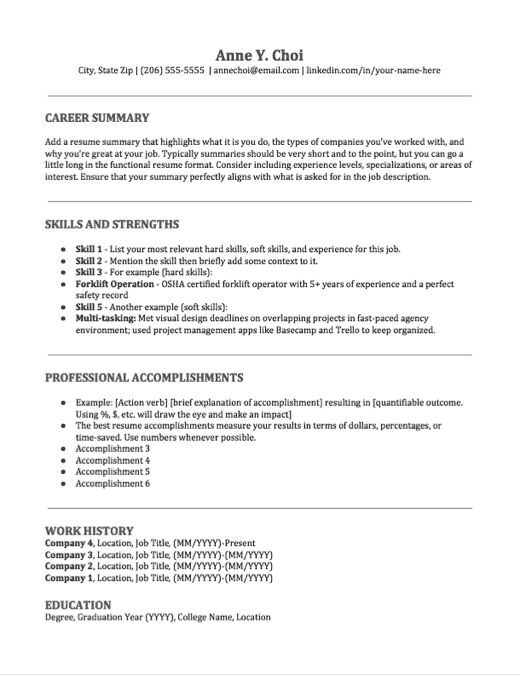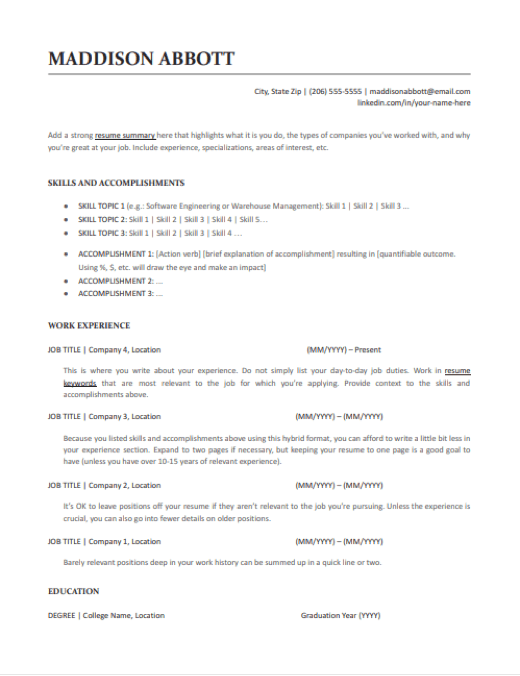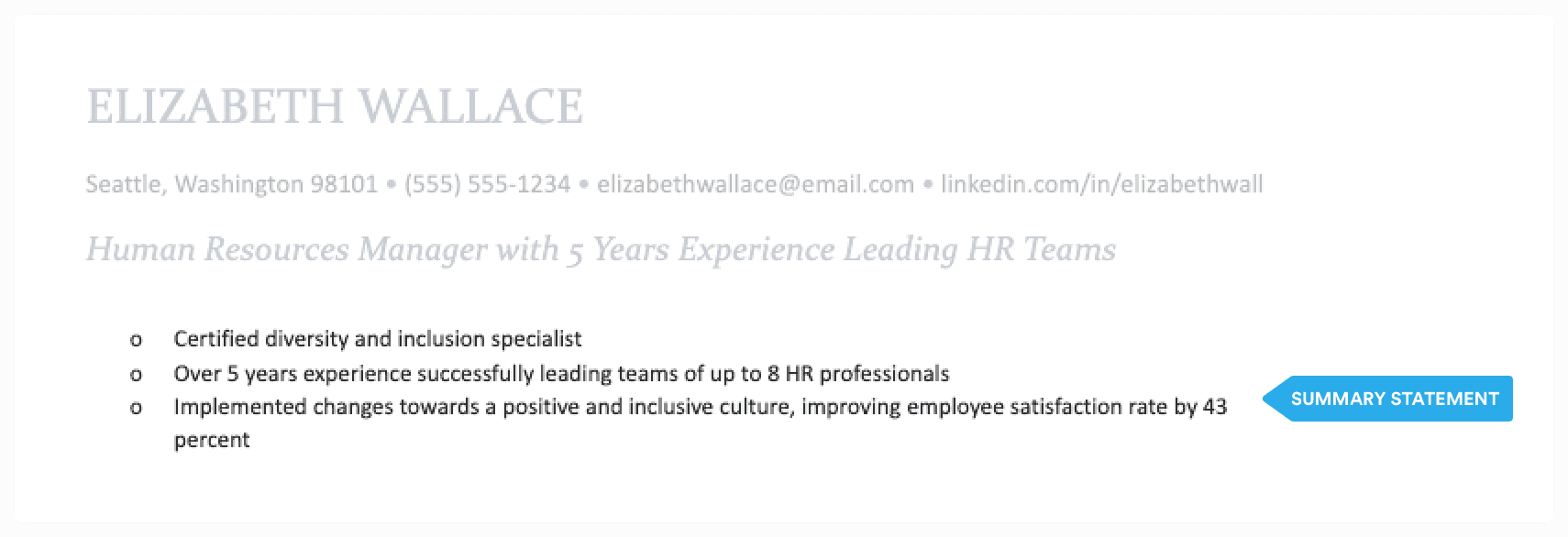
Step 1. Choose a resume format
The right resume format can help highlight your strengths and downplay your weaknesses. It can also make it easier for recruiters to scan your resume and identify the key information they are looking for.
There are three standard resume formats to choose from.
Chronological Resume
This is the most popular resume format, especially for job seekers with lots of relevant experience. This format lists your work history in reverse chronological order, with your most recent jobs listed first. It’s ideal for:
- Job seekers with a lot of professional work experience.
- People with no employment gaps.
- Those who want to showcase their career progression over time.
See an example below;

Functional Resume (also known as a Skills-Based Resume)
The functional resume is organized around your transferable skills and abilities rather than your work history. It helps you downplay your lack of experience in a particular field. While it is helpful for certain situations, it’s not always the best. Recruiters sometimes don’t like the functional resume format because it can make it seem like you’re trying to conceal something. So be wary of that.
Under each skill you list, try to add bullet points that provide specific examples of times when you’ve used that skill. This format is ideal for:
- Recent graduates
- Entry-level job seekers
- Career changers
- Those with gaps in their employment history
See an example below;

Hybrid Resume (also known as a Combination Resume)
A hybrid resume can be a great way to showcase both your work history and your skills. For many job seekers, it’s the best resume format. With this format, you would begin with a brief overview of your skills and accomplishments, followed by a chronological listing of your employment history. This format is ideal for:
- Mid-level job seekers with some experience in their field.
- Career changers who need to highlight transferable skills.
- People reentering the workforce.
See an example below;

Step 2. Add your contact information and personal details
This is one of the most important sections of your resume. If hiring managers can’t contact you, it doesn’t matter how great the rest of your resume is. So, you need to make sure that your contact info is accurate and up to date.
The following information should appear at the top of your resume:
- Name
- Phone number
- Location (City, State, Zip Code)
- Email Address
- LinkedIn profile URL
Here’s an example:

Step 3. Write a standout resume headline
One way to make sure your resume stands out is to write a catchy headline. This is a concise, one-line description of who you are as a candidate.
A well-written headline can grab a recruiter’s attention and encourage them to take a more detailed look at your resume. It can also highlight your most relevant skills and experience, making it easier for recruiters to see why you would be a good fit for the role.
You should place your headline near the top of your resume, so it’s one of the first things that a hiring manager or recruiter sees.
Here’s an example:

Resume headlines are most beneficial for people who have a lot of relevant experience, but anyone can use them.
If you don’t have any experience or are applying for an entry-level job, you can use your resume headline to show off your soft skills, your proficiency with tools, or your winning personal attributes.
When writing your headline, it’s crucial to include the job title that appears at the top of the description of the job you’re applying for. This is the most impactful keyword of all, and the headline is a good place to put it, especially if you haven’t held the exact position before.
Step 4. Add your resume summary statement or resume objective
Most recruiters only spend between six and eight seconds looking at a resume before they make a decision about a job candidate, according to a study by Ladders.
This means you need to make a strong first impression! You can do this by adding a resume summary statement underneath your resume headline.
A summary statement is a brief paragraph or a set of bullet points that summarizes your professional qualifications.
Your summary statement should expand on your resume headline and provide evidence of your skills, achievements, and experience.
Here’s an example:

Resume summaries are ideal for job seekers who have plenty of relevant work experience and accomplishments that can be tied to actual numbers.
If you don’t have much job experience or are changing careers, you could write a resume objective statement instead.
Your resume objective basically explains what the object of your resume is. It is a short statement that communicates your reason for wanting to work in a new field. It should include:
- The job title or field you are interested in.
- Any transferable skills that make you a good fit for the position.
- Relevant accomplishments that demonstrate how you would excel in the new role.
- Your career goals and how the position you are applying for can help you achieve them.
For example, if you are a recent college graduate seeking a position in marketing, your resume objective might state: “To secure a position in marketing where I can utilize my creativity and analytical skills to contribute to the company’s success.”
Read the full guide: Resume Objective Statements: Examples, How-To, and FAQ
Step 5. Add keywords and skills that are ATS-friendly
Before you move on to the next step, it’s important to determine what keywords and skills you need to have on your resume.
Why? Because when you submit your resume, it most likely won’t go to a live human being – it will go straight into a computer database.
Employers receive hundreds and even thousands of resumes for every job opening. They don’t have time to look at all of them.
To solve this problem, many employers now use application tracking systems (ATS) to automatically collect, review, and sort resumes. In fact, 99 percent of Fortune 500 companies now use ATS to help them manage the hiring process.
Having the right keywords on your resume is important because hiring managers use keywords to search through their ATS database for the best job candidates.
These keywords are usually job titles or specific skills. If your resume doesn’t contain the keywords hiring managers are searching for, it will sit in the database, unseen.
Step 6. Detail your work experience
Now it’s time to get to the heart of your resume – the “work experience” section. This is the section employers will spend the most time looking at when they consider your resume.
If you get this part right you’ll be well on your way to creating a strong resume that will land you plenty of job interviews!
The first things a recruiter looks at on your resume are the job titles you’ve held and the companies you’ve worked with. Make this information easy to find by listing each job in reverse-chronological order (latest job first).
Each job should have its own subheading that includes the following information:
- Company name and location – Include the full name of the company you worked for followed by the city and state of its location.
- Job title – Be as specific as possible to ensure that employers know exactly what your role was within the company.
- Start and end dates – Include the month and year for each position. If you only list the year, it may appear as though you are omitting information.
- Achievements and responsibilities – These can be listed using bullet points. Include hard numbers and metrics wherever possible.
Our research has found that this sequence offers maximum applicant tracking system (ATS) compatibility. Here’s an example:

Our research has found that this sequence offers maximum applicant tracking system (ATS) compatibility. Here’s an example:
Tip #1: Highlight achievements as well as responsibilities
One of the biggest mistakes people make when writing a resume is only listing their job responsibilities. These are tasks that you’re expected to perform as part of your job. They can include things like:
- Answering customer questions and complaints
- Scheduling and coordinating appointments
- Taking inventory and ordering supplies
- Maintaining records and filing paperwork
- Training new employees
Listing your job responsibilities gives a potential employer an idea of what you did day-to-day, but it doesn’t reveal how well you did it.
That’s why it’s important to highlight your specific accomplishments in prior roles.
For example, if you increased sales, reduced costs, or implemented new processes or technologies, be sure to mention these accomplishments.
Instead of writing “managed a team of 12 people,” write “managed a team of 12 people, consistently meeting or exceeding quarterly targets.”
This not only demonstrates that you are an asset to any organization, but it gives employers confidence that you’re capable of handling the job.
Here’s an example of a resume that does a good job of listing both responsibilities and accomplishments:
Not every career lends itself to easily-quantifiable achievements. For example, someone who works in a warehouse might have responsibilities that include stocking shelves, unloading trucks, and packaging items for shipment.
While these responsibilities might not seem like much, they’re actually essential for keeping the warehouse running smoothly. The ability to work efficiently and effectively is a valuable skill in any field.
So, next time you’re feeling like you don’t have anything to list as an accomplishment, take a step back and look at the bigger picture. Chances are, you’ve achieved more than you realize!
Read the full guide: 6 Steps to Writing Your Resume Work Experience
Tip #2: Use action verbs
Action verbs are key when it comes to writing an engaging and compelling resume. They help paint a clearer picture of your qualifications and increase the overall impact of your resume.
Instead of simply stating that you were “responsible for” a certain task or project, explain how you took charge and made it happen. For example, you could say that you “spearheaded” a new initiative or “coordinated” a complex team effort.
By using powerful verbs, you’ll not only make your resume more interesting to read, but you’ll also demonstrate the kind of can-do attitude that employers are looking for.
Read the full guide: 400+ Resume Action Words (Plus 100 Power Verbs Recruiters Love to See)
Tip #3: Use active voice, not passive
Always try to use an active voice instead of a passive voice when writing your resume.
In an active voice, the subject of the sentence is doing the verb. For example, “The cashier counted the money.” In a passive voice, the subject is being acted upon by the verb. For example, “The money was counted by the cashier.”
Active voice is preferred over passive voice because it’s more direct, concise, easier to read, and it makes you sound more confident and authoritative.
When used with an action verb, an active voice can subconsciously influence a recruiter into thinking that the applicant is competent and capable. For example, “managed a team of 12” is more powerful than “was responsible for a team of 12.”
Read the full guide: Resume Words: Keywords, Adjectives, Skills, and Power Verbs
Tip #4: Use numbers
One of the best ways to make your resume stand out is to use numbers. In fact, job seekers who use numbers in their resumes increase their hireability by 40%, according to a study by TalentWorks.
Whenever possible, quantify your achievements with numbers that illustrate the scope of your work. For example, instead of saying “created marketing campaigns,” you could write “created 10 successful marketing campaigns that generated a 20% increase in leads.”
By using numbers, you give hiring managers a better sense of your value, making it more likely that you’ll land the job you want.
Here are some more examples of using numbers (with action verbs underlined):
- Saved $7 million while introducing nationwide transport service for medical patients.
- Generated a utility income increase of 45% within 2 months by designing and deploying an enhanced bill back process.
- Achieved 150% sales growth by leading a multifunctional team to define, refine, and roll-out a cross-channel, ten-year brand strategy.
Finally, If you have gaps in your employment history, be prepared to explain them in a cover letter or during an interview.
However, don’t let a few months or years off work deter you from applying for a position – focus on highlighting your skills and strengths, and let your work experience speak for itself.
Read the full guide: Wordsmithing Your Resume: Tenses, Plurals, and Optimized Keywords
Step 7. Showcase your skills
When writing your resume, be sure to include a skills section. This is the perfect place to mention all the skills and know-how that make you the ideal candidate for the job.
Pay particular attention to the skills that are listed in the job description of the position you are applying for. As we’ve seen, including these keywords on your resume greatly increases the chance that your resume will be seen by an actual hiring manager, leading to a job interview.
There are two types of skills you can include in your skills section: hard skills and soft skills.
Hard skills are the specific skills and knowledge that you need to perform a certain task or job. They are usually quantifiable and easy to measure. Examples of hard skills include:
- Computer programming
- Copywriting
- Data analysis
- Programming
- Accounting
- Graphic design
- Web development
- SEO
Soft skills, on the other hand, are interpersonal skills that help you interact with others. They are more difficult to quantify but are just as important in the workplace. Examples of soft skills include:
- Communication
- Leadership
- Teamwork
- Problem solving
- Time management
- Self management
- Critical thinking
- Flexibility
Soft skills are important because they’re transferable. This means they can be applied to any number of settings and can help you succeed in any type of job.
Also, unlike hard skills, which can become outdated quickly, soft skills are always in demand. As the world changes and technology advances, soft skills will become even more important.
Here’s an example of a skills section for a mechanical engineer that includes both hard and soft skills:
Read the full guide: Top Resume Skills and How to List Them
Step 8. Add your education and certifications
You need to include your education somewhere on your resume, but where it appears depends on your individual circumstances.
If you are just starting out in your career, it’s generally a good idea to include your education section near the top of your resume. Recent grads can include relevant coursework, societies, organizations, and extracurriculars that strengthen their candidacy.
However, if you are a few years into your career, your education can appear at the bottom of your resume. This is because your work experience will be more relevant to potential employers at this point in your career.
Unless you’re applying to a job that puts extra emphasis on education (like academia, law, or medicine), most job seekers can get away with providing only the following information on their resume:
- Name of school
- School location
- Degree
- Year graduated
Read the full guide: How to Format Your Resume Education Section: Tips and Examples
If you have earned any professional certifications that are relevant to the job you are applying for, then you should definitely include them on your resume.
You can list your certifications right under your education information. Be sure to include the name of the certification, the issuing authority, and the date of certification. If the certification is still valid, you can also mention that.
If you have earned multiple certifications, then you can list them in order of importance, with the most relevant ones appearing first.
Here’s an example of what the education section looks like on a pharmacist’s resume:

Read the full guide: 8 Free Certifications to Add to Your Resume
Step 9. Additional resume sections (optional)
Your resume is your opportunity to shine. It’s your chance to show potential employers who you are and what you’re capable of.
One way to really stand out is to include additional information that showcases your skills and accomplishments. If applicable, consider adding the following resume sections:
Languages
In today’s global economy, knowing foreign languages can give you a competitive edge over other candidates. Many businesses are looking for employees who can communicate with customers and clients in their native language.
On your resume, list the languages you speak in order of proficiency, starting with your strongest language. Also, specify whether you are fluent, proficient, or conversational in each language. For example:
- Fluent in Spanish and English
- Proficient in French and conversational in German
- Conversational in Japanese
Hobbies and interests
Many people believe that hobbies should remain separate from their professional lives. However, including information about your hobbies on a resume can actually give employers a better sense of who you are as a person.
For example, if you enjoy hiking, it shows that you are physically active and have a sense of adventure. If you enjoy cooking, it shows that you are creative and have a keen interest in food.
When listing your hobbies, make sure to keep it short and sweet. You don’t need to go into great detail about every single hobby you have. Just mention a few that you think are relevant and leave it at that.
Publications
If you have been published in any capacity, it is generally a good idea to include this information on your resume, especially if it’s relevant to the job you’re applying to. Most employers love to see that you can communicate effectively in writing.
If you’re not sure where to start, list any published articles, blog posts, books, or even whitepapers that you have written. Be sure to include the title, publisher, and date. For example:
“The Impact of Social Media on Businesses.” The Journal of Business, December 2021.
Awards
If you have won any awards that are relevant to the job you’re applying to, you should absolutely include them on your resume. Awards will impress potential employers and help you to stand out from the competition.
Be sure to list the name of the award, the date you received it, and a brief description of the award. For example:
“Top Salesperson” (January 2020) – Awarded to the salesperson with the highest sales numbers for the month.
Volunteer experience
If you have any volunteer experience, don’t forget to add it to your resume!
According to a LinkedIn survey, 20% of employers say they have hired a candidate because of their volunteer experience. The survey also showed that job seekers who volunteer are 27% more likely to be hired than non-volunteers.
When adding your volunteer experience to your resume, list the name of the organization, the dates of your service, and a brief description of your duties and responsibilities. For example:
Woodstock Food Bank, Jan 2019-present
- Led a team of 10 volunteers in sorting and distributing donated items to local families in need.
- Organized monthly food drives that collected an average of 500 lbs of food per month.
Personal projects
Many professionals use their skills outside of the office. In fact, 57 million workers participate in the gig economy in the US.
Adding your side projects to your resume can be a great way to demonstrate your commitment to lifelong learning and professional development.
Examples of personal projects include designing websites, creating a YouTube channel, coding apps, writing a book, running an ecommerce store, consulting, or starting any kind of new business.
When choosing personal projects to include on your resume, be sure to select those that are most relevant to the position you are applying for.
Step 10. Format your resume so it can be easily read by an ATS
Formatting your resume correctly is absolutely vital if you want to get more job interviews.
Why? Because your resume most likely will go straight into a computer database (ATS) after you submit it. If your resume can’t be read by the ATS due to formatting issues, then all your hard work will be for nothing.
So pay close attention to these formatting do’s and don’ts!

Read the full guide: The Best Fonts for Your Resume
Step 11. Add a cover letter
When you submit your resume, you’ll most likely also have to submit a cover letter.
Think of a cover letter as a quick preview of your skills and experience. The goal is to make the hiring manager interested in you so they will want to learn more.
The best cover letters are usually one page long so the message is clear and easy to understand.
How to Write a Cover Letter
- Contact Information – Include your full name, address (including zip code), and phone number with area code. Your contact information should be in the upper left corner of your cover letter.
- Greeting – Ideally, you should find out the name of the hiring manager and greet them directly. You can usually find the hiring manager’s name by searching the company website or even calling the company and asking which hiring manager is assigned to this particular position.
- Opening – Think of your opening sentence as your chance to grab the hiring manager’s attention and get them excited to learn more about you. What can you do that nobody else can?
- Body – You need to sell yourself in this section. The best way to do this is by providing examples of your measurable accomplishments. These are powerful because they show tangible proof of your abilities. Only include the most relevant and positive information about yourself in your cover letter.
- Closing – This section is used to thank the hiring manager for their time and to point out any attachments (website, portfolio, samples). Be professional and don’t sound too eager, or you might sound desperate.
- Use Keywords – If you can, use some of the same keywords from the job description in your cover letter. This will show employers that you have read through the job description carefully and that you understand what they are looking for in a candidate.
A great cover letter can make all the difference when applying to a job. It allows employers to see beyond your resume and get an idea of who you are as a person—and if you would be a good fit for their company culture.
By following these tips, you can write a great cover letter that will improve your chances of getting an interview!
And last but not least…
Remember to thoroughly proofread your resume and cover letter!
Proofreading is one of the most important things you can do before sending off your application. A single typo or mistake can make you look unprofessional and could cost you the job.
If you don’t think your proofreading skills are good enough, ask a friend or family member to help you out. You can also use a free online proofreading tool like Grammarly.
Remember, sending your resume off without carefully proofreading it could spell disaster. So be sure to take the time to update your resume and review it for typos and errors. It could make all the difference in whether or not you get a job interview.
Read the full guide: 7 Steps for Choosing and Using Job References
Culled from: www.jobscan.co
